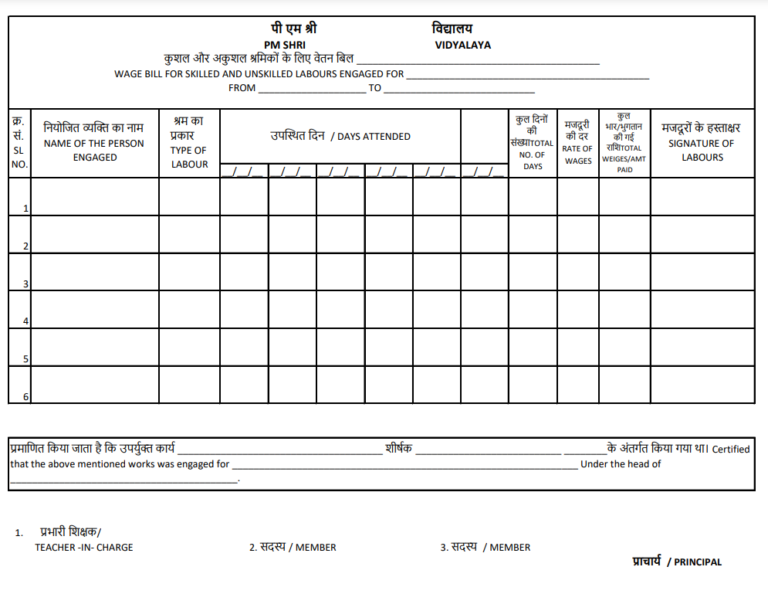
Table of Contents
Labour Attendance Sheet: A Comprehensive Guide
A Labour Attendance Sheet is a crucial document used to track the daily attendance, work hours, and productivity of laborers or workers at a job site. It serves as an essential tool for payroll processing, project management, and legal compliance. This document can be maintained manually, digitally, or using biometric systems, depending on the size and nature of the workforce.
In industries such as construction, manufacturing, agriculture, and other labor-intensive sectors, accurate attendance tracking is vital. This ensures fair wage payment, minimizes disputes, and promotes workforce transparency.
Importance of a Labour Attendance Sheet
- Accurate Wage Calculation: Labour attendance sheets help employers calculate daily wages, overtime pay, and deductions. Since many laborers are paid based on daily attendance, this record becomes the foundation for wage calculations.
- Compliance with Labor Laws: Legal regulations often require employers to maintain attendance records. This ensures compliance with wage laws, overtime regulations, and employee rights.
- Monitor Worker Productivity: Attendance sheets track which workers are present on-site, allowing supervisors to plan daily tasks, avoid project delays, and identify absenteeism trends.
- Proof for Dispute Resolution: In case of wage disputes, wrongful termination claims, or audits, an attendance sheet serves as evidence of the employee’s work history.
- Facilitates Payroll Processing: It streamlines the payroll process by providing a clear record of each worker’s working hours, ensuring timely payment and accurate wage calculations.
Types of Labour Attendance Sheets
- Manual Labour Attendance Sheet:
- Description: A simple paper-based register where workers manually mark their attendance. It typically includes columns for worker name, date, time-in, time-out, total hours, and overtime.
- Pros: Cost-effective and easy to set up.
- Cons: Prone to human error, difficult to update, and can be tampered with.
- Excel/Spreadsheet Attendance Sheet:
- Description: A digital version of the manual sheet, created using software like Excel or Google Sheets. This format allows for automatic calculations of total hours, overtime, and wages.
- Pros: Easy to update, calculate wages automatically, and share with others.
- Cons: Requires some technical knowledge and can be time-consuming for large workforces.
- Biometric Attendance System:
- Description: Uses fingerprints, facial recognition, or ID cards to track attendance automatically. This system captures entry and exit times with precision.
- Pros: Highly accurate, prevents fraud, and saves time.
- Cons: Expensive to set up and maintain, especially for small businesses.
- Mobile App Attendance Tracker:
- Description: Mobile applications allow workers to check in and out from their smartphones. GPS tracking ensures that workers are on-site when marking attendance.
- Pros: Ideal for remote worksites, real-time tracking, and easy reporting.
- Cons: Requires access to smartphones and the internet.
Key Components of a Labour Attendance Sheet
- Date: The specific date for which attendance is recorded.
- Worker’s Name: Full name of the employee or laborer.
- Employee ID or Code: A unique identifier assigned to each worker for easy tracking.
- Shift Details: Morning, afternoon, or night shift details (if applicable).
- In-Time and Out-Time: Records the time when the worker enters and exits the job site.
- Break Time: Optional column to track lunch or tea breaks.
- Total Hours Worked: Total hours spent at work after excluding break time.
- Overtime (OT) Hours: Additional hours worked beyond regular working hours.
- Attendance Status: Marks the worker as Present (P), Absent (A), or Leave (L) for that day.
- Signatures: Both the worker and supervisor may sign the sheet for verification.
How to Prepare a Labour Attendance Sheet
- Design the Layout:
- Use tools like Excel, Google Sheets, or paper registers.
- Include necessary columns like worker’s name, date, in-time, out-time, and total hours worked.
- Input Worker Information:
- List the names of all workers for the specific project or worksite.
- Assign unique employee IDs if needed.
- Daily Attendance Marking:
- Supervisors or site managers should mark attendance daily. For biometric or app-based tracking, it’s done automatically.
- Record Work Hours and Overtime:
- Track when employees start and end their shifts. Calculate overtime hours separately.
- Review and Verify:
- At the end of the shift or workday, review the attendance sheet for accuracy. Workers and supervisors should sign to confirm its correctness.
Benefits of Using a Labour Attendance Sheet
- Reduces Payroll Errors: Accurate tracking ensures workers are paid correctly for the hours they work.
- Improves Accountability: Ensures that employees adhere to their schedules and minimizes absenteeism.
- Time-Saving: Automated attendance sheets in Excel or biometric systems reduce the administrative burden.
- Dispute Resolution: Provides evidence to resolve wage-related disputes with workers.
- Legal Compliance: Helps employers meet labor law requirements related to employee attendance and wage payments.
Challenges in Managing a Labour Attendance Sheet
- Human Error: Manual sheets are prone to errors, such as missed entries or incorrect data.
- Fraud and Misuse: Workers may forge attendance in manual systems.
- Time-Consuming: Manually calculating total hours, overtime, and wages can be tedious.
- Data Loss: Physical registers can be lost or damaged, leading to loss of data.
Solution: Using biometric systems or digital attendance tracking apps can reduce errors and increase efficiency.
Labour Attendance Sheet Format
| Date | Employee Name | Employee ID | Shift | In-Time | Out-Time | Break Time | Total Hours | Overtime Hours | Status (P/A/L) | Signature |
|---|---|---|---|---|---|---|---|---|---|---|
Conclusion
A Labour Attendance Sheet is essential for businesses employing daily wage workers or laborers. It tracks attendance, work hours, and overtime, forming the basis for payroll, workforce planning, and compliance with labor laws. Employers can choose from manual, digital, biometric, or app-based tracking systems, depending on the size and complexity of their workforce. By implementing a well-structured attendance tracking system, businesses can improve wage accuracy, reduce errors, and enhance productivity.
